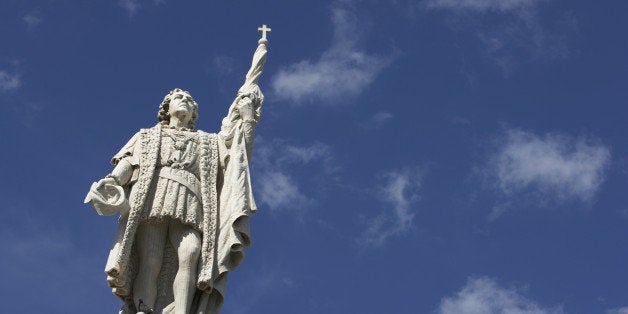
As most of us know -- there is no reason on the planet for the United States to observe at least two of its holidays -- Columbus Day and Thanksgiving. Both for basically for the same reason.
The United States' perception of Christopher Columbus is filled with erroneous information. He was a killer. But yet we stand by this geneocidal tactic of celebrating one who didn't just marginalize a people, but mutilated them. Though he may be long dead, his legacy is not.
The social consequences of invasion of the Americas continue through this day, not to mention the impact on our environment. All must pull together in unity to reverse the injustice and racism that started in 1492. Do we have the will to do so? I guarantee you some of us do.
Earlier this year I was in a business establishment where several were gathered, one of whom was a teacher. I asked her about Arizona's banning of multiple ethnic textbooks and resource materials a couple of years ago, including several that are Native American in their thematic content. I brought up Rethinking Columbus -- A TEACHER RESOURCE -- that had been banned, and shared with her that it is an accurate and thorough subject review of this demonic individual so poised in America's history. And this teacher asked why on earth would I say that, why would I advocate abolishing this holiday? (Oh... if she only knew all that I would advocate for to change, abolish and make restitution for...) What follows is part of what I told her. All information can be found in a variety of texts, including Rethinking Columbus, which I think should be mandatory reading in schools and elsewhere.
•The indigenous peoples of the Americas stood in the way of European 'progress' via western expansion. What followed was rape, murder, destruction, all forms of genocide, land and resource destruction and theft. Columbus led the charge. His portrayal as the man with the hat and ships who came to befriend the Natives is utter (searching for a word here fit for print) fallacy. The romantic myth is a complete falsehood.
•Tens of thousands of indigenous people were killed because they would not convert to a religion completely foreign to them, one of which they understood neither the content nor the language that was being spoken to them. Estimates of the indigenous population in 1451 (year of Columbus' birth) 70 to 100 million people in what will be called the Americas in the future.
•In terms of Columbus arriving on Americas' lands -- invasion and conquered. The term 'discovered America' is nonsense. How do you 'discover' a land inhabited by millions? "Discovery presents the point of view of the supposed discoverers. It's the invaders masking their theft. And when the word gets repeated in textbooks, those textbooks become, in the phrase of one historian, 'the propaganda of the winners.' "(Bill Bigelow) Columbus did two things -- discover and destroy. History records the first question he tried to ask "if they had gold." Two days later his thoughts turn to adding slavery to the equation.
•After landing October 12, 1492, by November Columbus kidnapped ten Tainos Indians. According to his journal, "brought seven head of women, small and large, and three children." On the 17th it is recorded two escaped. He returns to Spain in February with six Indians, one stayed in Spain and died within two years. Three others die shortly aboard a ship with Columbus.
•Most textbooks end with the inaccurate retelling of Columbus' first visit to the Americas. Very convenient. On his 2nd voyage in 1495, he and his men captured some 1,500 Arawaks - men, women, children. However, the ship could only hold 500. The best 'specimens' were loaded onboard; other Spaniards were allowed to take as many of the remaining for their own slaves to do with as they wished. Of the 500 slaves Columbus took to Spain, 300 arrived alive, where they were put up for sale, naked. Those that died? Their bodies were thrown overboard.
•In November of 1493 Columbus lands on 'Dominica'. His men ordered to go ashore to loot and destroy everything in sight. They capture 12 young girls. You can likely envision their fate with the so-called 'men' of Columbus' crew.
•In 1494 a priest writes of the atrocities being committed where he cites violence, cruelty, plunder and slaughter occurring on a daily basis. (Father Bartolome de las Casas)
•As the invasion continued, every male and female aged 14 and up, had to collect gold for the Spaniards. "Every three months, every Indian had to bring one of the forts a hawks' bell filled with gold dust. The chiefs had to bring in about 10 times that amount..." If this task was accomplished they received a copper token to wear around the neck, indicating they were safe for another three months while collecting their next portion. Failure? Their hands were cut off...and they died. "During those two years of the administration of the brothers Columbus, an estimated one half of the entire population of Hispaniola was killed or killed themselves. The estimates run from one hundred and twenty-five thousand to one-half million." (Columbus: His Enterprise by Hans Koning) The motive? GREED and POWER.
•Another enterprise of Columbus was the 'discovery' of sugarcane. Deadly for the indigenous people enslaved to work the harvest. Caring less about humanity than money, lots of slaves were needed, the clearing of as much land as possible was needed, and controlling the slaves took preeminence. By 1505 after the Spaniards forced the Indians to work for them, the Indians disappeared -- driven away or more likely killed by overwork, disease, murder and...suicide. It was at this time that Africans were then imported as slaves.
•During the sugarcane plantation days, slaves worked at the grinding mills -- rollers that crushed the cane. Fingers or hands caught in the machine could pull a full-sized adult into the machine, so it was one man's job to stand by with a hatchet, to chop off an arm if it was caught in the rollers, as happened periodically. Manacles, whips, guns, swords, and torture were all used to 'control' the slave.
•Columbus is represented as a 'devout Christian' in virtually any text you read. Where is the mention of Native spirituality, a force that guided and cared for them? Is God truly 'on your side' when forced upon you with death as the alternative? Darker skinned, unarmed, non-Christians - the formula for the conquered. Such was (is?) the foreign policy of the time.
•Where is our attention to the legacy of a butchered people at the hands of Columbus and his men? And if it is mentioned, that is exactly that -- a mere mention. What about the horrific nightmare and consequences for those left behind that followed? Human beings were commodities measured in gold, the environment of no value except for what resource it could be raped for.
•"Why does the United States commemorate a Columbus Day instead of a Genocide Day?" (Bill Bigelow)
•Later in history but in direct relation to Manifest Destiny, leaders in power began offering bounties for the scalps of Indian men, women and children. In 1703, the Massachusetts Bay Colony paid $60 for each scalp. In 1758, different awards depending on whether it was a man, woman's or child's scalp. The offering of bounties increased the level of violence with the true intent pointed at the complete erasure of Indians from the face of America.
•Was there resistance to the invasion? Of course. Do many textbooks or books talk about it? Of course not. Now why...might...that...be?
Had enough? I understand.
The facts are endless, and most absent from what any of us have learned or are learning. We don't know, and we generally don't ask, the unasked questions. Perhaps it is easier for this country to hide its head in the sand and not recognize her true history. Not to mention current disputes, racism and general failure to care.
Ban Columbus Day? Yes. This year what will you do to change October?
And about that textbook ban...
In the end, who does Arizona think it is to ban ethnic studies textbooks? And who are the citizens of Arizona that they would tolerate such actions? In terms of contemporary America, it is questionable if they want to recognize Native Americans today, from the problems of severe poverty to the amazing leadership and accomplishment that is emerging and has been for a long time. The very LEAST the schools can do is give an honest accounting of what has happened, what is happening, and the call for unity....
Many of today's textbooks either through outright misrepresentation or omission do not teach an accurate history nor do they give honest reporting of the issues facing Indian Country today, or to the Indigenous leadership that is making a difference.
And the point of education is ???
References:
Rethinking Columbus: The Next 500 Hundred Years, Bigelow/Peterson, Rethinking Schools, Ltd. Milwaukee, WI 1998 ISBN - 10:0-942961-20-X ISBN-13: 978-0-942961-20-1 www.rethinkingschools.org
This post first appeared in Whisper n Thunder. Cross posted with permission of the author.
